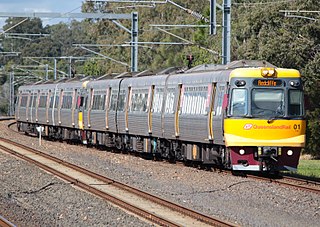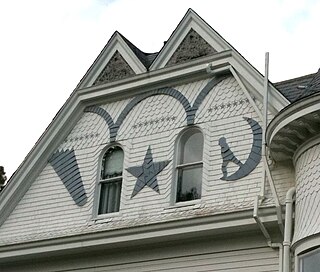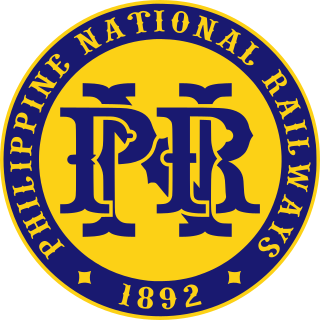
The Philippine National Railways (PNR) is a state-owned railway company in the Philippines, operating a single line of track on Luzon. As of 2016, it operates one commuter rail service in Metro Manila and local services between Sipocot, Naga City and Legazpi City in the Bicol Region. PNR began operations on November 24, 1892 as the Ferrocarril de Manila-Dagupan, during the Spanish colonial period, and later becoming the Manila Railroad Company (MRR) during the American colonial period. It became the Philippine National Railways on June 20, 1964 by virtue of Republic Act No. 4156. The PNR is an agency of the Department of Transportation.

Los Angeles Union Station (LAUS) is the main railway station in Los Angeles, California, and the largest railroad passenger terminal in the Western United States. It opened in May 1939 as the Los Angeles Union Passenger Terminal, replacing La Grande Station and Central Station.
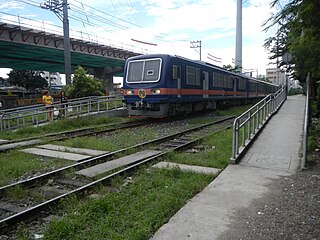
Rail transportation in the Philippines presently is used mostly to transport passengers within Metro Manila and the nearby province of Laguna. Freight transport is nonexistent, although there are plans for a revival from Port Area, Manila to Laguna, and a cargo train planned between Subic and Clark. Currently, the country has a railway footprint of only 77 kilometres through Line 1, Line 2, Line 3 and the Philippine National Railways (PNR) Metro Commuter Line. This situation will change in the immediate future as the government has plans to expand its current footprint to more than 320 kilometers by 2022.

The Manila Light Rail Transit System Line 2, also known as MRT Line 2, MRT-2, or Megatren, is a rapid transit line in Metro Manila in the Philippines, generally running in an east-west direction along the Radial Road 6 and a portion of the Circumferential Road 1. Although operated by the Light Rail Transit Authority, resulting in its being called "LRT-2", it is actually a heavy rail, rapid transit system owing to its use of electric multiple units instead of the light rail vehicles used in earlier lines and is presently the only line utilizing such vehicles in the country. Envisioned in the 1970s as part of the Metropolitan Manila Strategic Mass Rail Transit Development Plan, the eleven-station, 13.8-kilometer (8.6 mi) line was the third rapid transit line to be built in Metro Manila when it started operations in 2003. It is operated by the Light Rail Transit Authority (LRTA), a government-owned and controlled corporation attached to the Department of Transportation (DOTr) under an official development assistance scheme.

San Fernando City station or simply San Fernando station is a defunct railway station of the PNR Northrail line of Philippine National Railways. It is situated San Fernando, Pampanga. Historically, the old PNR train station was the site of a stopping place for Filipino and American prisoners of war during the Bataan death march in 1942.

Santa Mesa station is a station on the South Main Line (Southrail) of the Philippine National Railways. Like all PNR stations, the station is at grade. It is located on an unnamed road near Ramon Magsaysay Boulevard in Santa Mesa, Manila, making it one of two stations to have its own access road. The station is named after the district where it is located.
San Pedro Relocation Center National High School (SPRCNHS) is a public secondary high school located at Barangay Langgam, San Pedro, Laguna, Philippines. It offers K-12 Basic Education Program by the Department of Education.
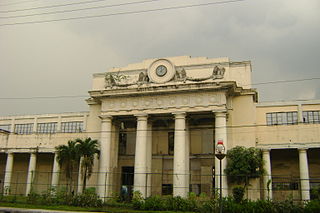
Paco is a station on the Southrail line of the Philippine National Railways. It serves Paco in Manila, Metro Manila. This is also the last station beside Quirino Avenue before turning left towards Pres. Sergio Osmeña Highway.
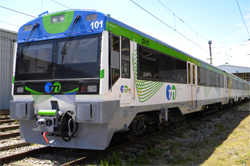
The Metrotrén, is a Chilean commuter rail system operated by Trenes Metropolitanos S.A., a subsidiary of the Empresa de los Ferrocarriles del Estado (EFE), that covers 13 communes using two lines: one to Nos and one to Rancagua. It is connected with the santiago metro at Alameda station.

Pasay Road is a station on the South Main Line ("Southrail") of the Philippine National Railways. Like all PNR stations, this station is at grade. The station is located on Estacion Street in Barangay Pio del Pilar in Makati, making it only one of two stations to have its own access road. It is named after Pasay Road, the old name of the Makati section of Arnaiz Avenue.

The transportation system in Metro Manila is woefully inadequate to accommodate the mobility and other basic needs of an overpopulated metropolis, the result of many factors and problems that the government has failed to provide or address. Metro Manila exists in a state of near-permanent gridlock, with people and goods trapped by the very transportation system that is supposed to move them quickly and efficiently. Because of the insufficient public transportation network, car ownership has risen dramatically, contributing further to the congestion that occurs at all times of day on the road. Filipinos view cars as tools to get them to where they need to go; they also believe that their car is an important symbol of the success they have achieved in life. In recent years, however, the Philippine government has been pushing to improve the system through various infrastructure projects, hoping to solve the interlinked problems of transportation, land use and environment.
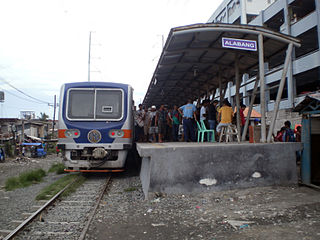
Alabang Station is a station on the South Main Line ("Southrail") of the Philippine National Railways. Like all PNR stations, this station is at grade. The station is located on T. Molina Street in Alabang, Muntinlupa, near the Alabang Viaduct of the South Luzon Expressway.

10th Avenue station is a brand new railway station of the Philippine National Railways (PNR) as part of Governor Pascual - FTI Line. Like all PNR stations, the station is at grade. It is located on 10th Avenue in Caloocan, near the original Caloocan railway station.

Caloocan railway station is a railway station of the Philippine National Railways (PNR) as part of the Governor Pascual - FTI line. It is rebuilt from its original location, now located and situated adjacent to Apolinario Mabini St., and along the railroad crossing on Samson Road in Caloocan, Metro Manila.
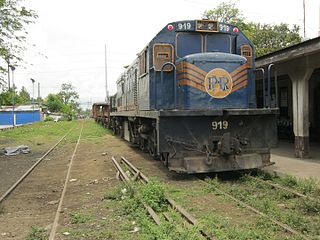
Biñan station is a station on the South Main Line ("Southrail") of the Philippine National Railways. Like all PNR stations, this station is at grade. The station is located on General Malvar Street in Barangay San Vicente, Biñan City, Laguna, near the city center.
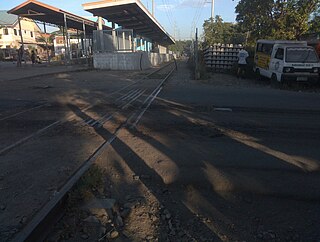
San Pedro station is a railway station on the South Main Line (Southrail) of the Philippine National Railways. Like most of the PNR stations operating under Metro South Commuter, the station is at grade. It is located in San Pedro, Laguna, within the city proper.
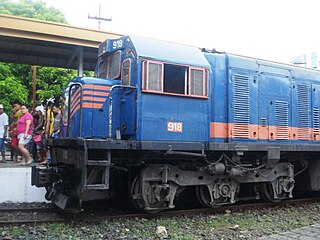
The PNR 900 Class is a class of 21 GE U14C and U15C locomotives that first appeared on the tracks of the Philippine National Railways in 1973. They were an extremely popular locomotive at the time and were used in the Bicol Express passenger train.
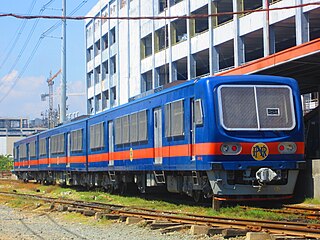
The Philippine National Railways Metro Commuter Line is a commuter rail line operated by the Philippine National Railways, stretching from Tondo, Manila to the southern and northern edge of Metro Manila. Presently, there are 31 railway stations. The current line is colored orange on most maps.

San Lazaro Tourism and Business Park is the marketing name given to the 16-hectare (40-acre) multiple use site under development by the Manila Jockey Club Investments Corp. in Manila, Philippines. It takes its name from the old San Lazaro Hippodrome, a horse racetrack that stood on the site from 1912 to 2003. Currently, the site includes the SM City San Lazaro shopping center, the two-tower Vertex office complex, the three-tower Celadon Park and Celadon Residences, and the five-tower Avida Towers San Lazaro condominium complex. It has been declared a tourism economic zone with information technology component in 2009.
